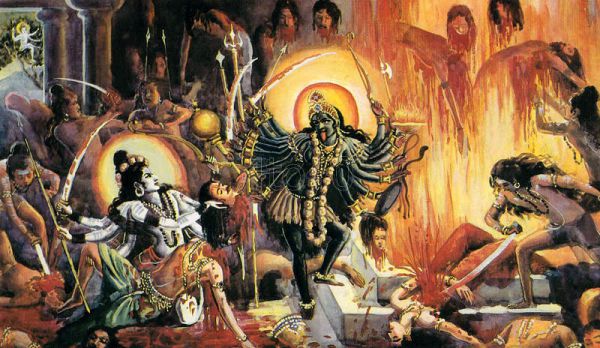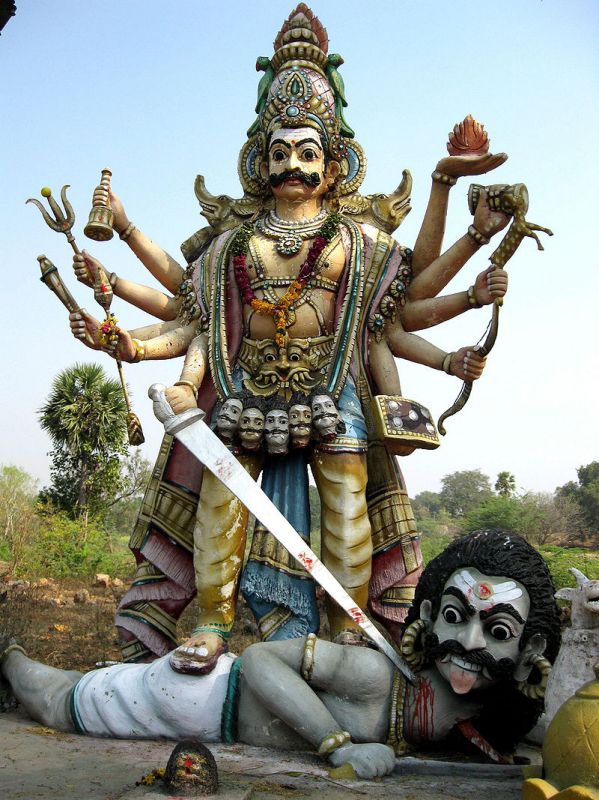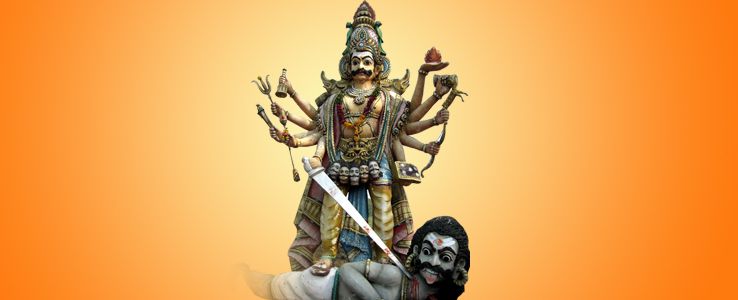No products in the cart.
Veerabhadra is part of Shiva’s Retinue, Shiva Pariwar, the other three being Nandi, Bhringi and Chandesvara. Veerabhadra is Shiva in ferocious mood, indeed Shiva manifested himself as Vira. This fierce warrior’s story is simply a symbolism of ego-shedding. He is a form of Rudra-Shiva who created him to act as his henchman in his quarrel with Daksha. He is also the principal deity of Virasaiva movement and still worshiped by bhaktas especially in the Karnataka region of India.
Three temples are dedicated to Veerabhadra in the main: Perambalur in Tamil Nadu, Lepakshi Temple in Anantapur and the other in the town of Veerabhadra near Rishikesh.
DEPICTION OF VEERABHADRA SWAMY:
The images of Veerabhadra depict the anger and ferocity of Shiva. In destructive mood, he wears a garland
of skulls, and with four arms holding four different kinds of weapons. Veerabhadra is a warrior god who was worshiped during wars in ancient and medieval periods. As an incarnation of Shiva, described as having a thousand heads, a thousand eyes, and a thousand feet; wielding a thousand clubs; and wearing a tiger’s skin. His consort Bhadrakali also came into being by Mother Devi’s wrath. Although auspicious, Bhadrakali assumes a fierce aspect, and is represented with three eyes, and four, twelve or eighteen hands. She carries a number of weapons, with flames flowing from her head, and a small tusk protruding from her mouth.
DAKSHA YAGNA:
The Trimurti (Trinity) quarrels continued into feud with Daksha, Brahma’s son. Prajapati Daksh is one of Lord Bramha’s Manas Putra. He was angered and began disliking Lord Shiva, when Lord Shiva had cut off Lord Bramha’s fifth head. He later married Prasuti, daughter of Svayambhuva Manu, and had many daughters, who married many devas and other rishis.
Prajapati Daksh’s youngest daughter, Sati was Goddess Adi Shakti‘s incarnation. She was very dear to him. But when he found out that she was in love with Shiva, he tried his best to keep her away from him. He once imprisoned her in the Daksh Rekha also.
Two of his daughters Revati and Rohini were married to Chandrama (the Moon Lord). But, Chandrama favored Rohini over Revati which eventually made her sad. When Daksh found out about it, he cursed Chandrama. Then Mahadeva revived Chandrama from this curse of his by placing him on his head.
In order to keep Sati away from Shiva, Prajapati Daksh arranged her marriage with Satbish, a very ugly looking man. To make Satbish handsome, he was advised by Lord Brahma to look for a sculptor named Jatta (who was in fact Lord Shiva himself). Jatta made a handsome sculpture of Satbish, thus making him handsome. But, then Daksha asked Jatta to make him another sculpture, that of Shiva as a dwarpal, which was made by Jatta. But soon, Satbish understood that Sati was only meant to marry Shiva and thus refused to marry her.
Feeling insulted, he arranged for Sati’s swayamvar. At the swayamvar, Sati chose Shiva by putting the garland around the neck of his statue. Even though Daksha refused the marriage, Lord Vishnu and Lord Brahma forced him to accept it. He was greatly upset by his daughter marrying Shiva.
Daksha had always hated Shiva. He did not leave a single chance to insult him. One day Daksha organized a grand yajna to which all the gods were invited, with the exception of Sati and Shiva. Wanting to visit her parents, relatives and childhood friends, Sati sought to rationalize this omission. She reasoned within herself that her parents had neglected to make a formal invitation to them only because, as family, such formality was unnecessary; certainly, she needed no invitation to visit her own mother and would go anyway. Shiva sought to dissuade her, but she was adamant upon going; he then asked Nandi(bull), the vehicle of Lord Shiva, to escort devi Sati and bid her not to provoke any incident.
VEERABHADRA AND BHADRAKALI:
Daksha holds the horse sacrifice without Shiva. This revenge was to miscarry. While all the gods went to the sacrifice, Sati pleads the father. Daksha repeats the strictures of the early assembly, upon which, in vindication Sati enters the sacrificial fire and gets consumed by flames. Sati, Shiva’s love was gone and he was devastated. An enraged Shiva tore a hair and created the fiercest warrior, Veerabhadra. His body was tall to reach the high heavens; he was as dark as the clouds; he had a thousand arms; three burning eyes, fiery hair and he wore a garland of skulls and carried terrible weapons. Mother Devi created Bhadrakali and provided Shakti energy. Thus Veerabhadra and Bhadrakali were born of the wrath of Shiva and Shakti and personified their anger.

Mahadeva created from his mouth a terrible sound, Being whose very sight could make one’s hair stand on its end. The blazing flames that emanated from his body rendered him exceedingly awful to behold. His arms were many in number and in each was a weapon that struck the beholder with fear. “I am known by the name of Veerabhadra’’ and I have sprung from the wrath of Rudra. This lady, who is my companion, and who is called Bhadrakali, has sprung from the wrath of the goddess.”
Veerabhadra was ordered to destroy Daksha’s horse sacrifice. Veerabhadra awaits instructions and this is described in Vaayu Purana: “Lead my army against Daksha and destroy his sacrifice; fear not the Brahmanas, for thou art a portion of my very self”. ‘Spoil the sacrifice of Daksha’. Then the mighty Veerabhadra, having heard the pleasure of his lord, bowed down his head to the feet of Shiva; and starting like a lion loosed from bonds, despoiled the sacrifice of Daksha, knowing that this had been created by the displeasure of Devi. She too in her wrath, as the fearful goddess Rudrakali, accompanied him, with all her train, to witness his deeds.
As directed by Shiva, this ‘fire of fate’ scattered all the gods and cut off Daksha’s head. Vishnu had a few roles to play here. According to Skanda Purana, when Veerabhadra confronted Vishnu, the former swallows his chakra. That was a lesson for Vishnu to conduct himself wisely. The gods send Vishnu to plead for Daksha’s life to complete the yagna favoring them. Next the defeated Gods sent Brahma to Kailasa. There Brahma prays to Shiva and asks for pardon. The all-merciful Shiva replaces Daksha’s burnt head with a goat’s head. Shiva is invited to the yagna. There Daksha shows reverence and all the gods salute Shiva. Thereafter Daksha becomes a great Shiva Bhakta. Shiva Tattva here is Lord Shiva representing the Higher Self; Sati as Shakti representing the Heart and Daksha representing the ego. Symbolism of losing your head is related to destroying ego.
Shiva stormed into Daksha’s home and gave himself to insane grief. He retrieved Sati’s body from the embers and clasped her so lovingly. But a lifeless Sati in his arms makes Him emotionally violent and the rhythm of Tandava, encompassing the world seven times with Sati in his arms, makes the universe suffer. Vishnu had to put a stop to this, lest the frenzy of mourning has no meaning to his preserving status. He cuts up Sati’s body, the Shiva-lila that marks the 51 powerful Shakti Peeths.
The Mahabaratha version makes clear the Trinity rivalry, making a lesser issue with Brahma than Vishnu’s race for supremacy. In Daksha’s sacrificial hall, Siva inspires fear with his arrow offerings. He hurled the Pinaka, his blazing lightning Trishula. This destroys the sacrifice which was held in honour of Vishnu and he is struck in the breasts but it is hurled back in equal vigor. Battle flared and as per myths Indra was trampled underfoot, Saraswati’s nose was cut, Mitra’s eyes were put out, Pushan’s teeth knocked off, Chandra was beaten, Agni’s hands were cut off and the whole universe quaked. This was all halted when Brahma intervened. Daksha then declares Shiva’s supremacy.
SYMBOLISM OF VEERABHADRA SWAMY:

Veerabhadra is not simply a murderous demon. Just as Shiva and destruction are an essential part of the Trinity, as destroyer, Veerabhadra, the Great Warrior, symbolizes that within ourselves we have the power to overcome the prideful ego – symbolized in stories by king Daksha; for the sake of the heart – symbolized by Sati, Daksha’s daughter and first wife of Lord Shiva. In the Daksha episode, Shiva represents the Higher Self; Sati or Shakti represents the heart and Daksha represents the ego. Thus the representation here is that the Higher Self destroys the ego for the sake of the heart. Through compassion the higher self forgives the ego but still withdraws to remember the essence of the heart.







The Veerabadhra And Badhrakali Article is Superb. it Contains Good Information for Devotees.